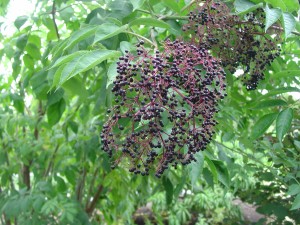Elderberry (Sambucus canadensis) is native to eastern North America, commonly found growing in open fields, thickets, fence rows, and along roadsides. Elderberry has pinnate leaves with toothed leaflets. Large flat clusters of small white flowers are evident by early summer, followed by large clusters of round purple-black fruit in late summer and fall.
The fruits are magnets for attracting all kinds of winged and four legged wildlife to your garden. They are tasty, high in vitamin C, and should be boiled into jelly, jams, and pies. The juice may be fermented into wine. Green berries, sap, and stems are toxic and, when not cooked, the calcium oxalate crystals they contain may damage to human kidneys.
Elderberry prefers an average moist compost rich soil in full to partial sunlight. The soil pH should fall between 6.0 – 6.5. Fertilize at 6 – 8 oz of 10-10-10 fertilizer annually per shrub in early spring.
Shrubs tend to grow rapidly and may require a hard cutback every 2-3 years to restrict plant size and the aggressive suckering root system. Elderberries are generally maintained at 6-8 feet in height, but may be pruned shorter to accommodate a small garden patch. Plants should be set 5-6 feet apart.
Potential pest problems, such as powdery mildew, stem dieback, rust, leaf spots, viruses and insect borers, are best managed through judicious pruning in early spring.
Horticultural varieties include: ‘Adams’, ‘Johns’, ‘Nova’, ‘New York 21’ and ‘York’. Plant two or more different varieties for greater fruit yields.


 Posted in
Posted in 
